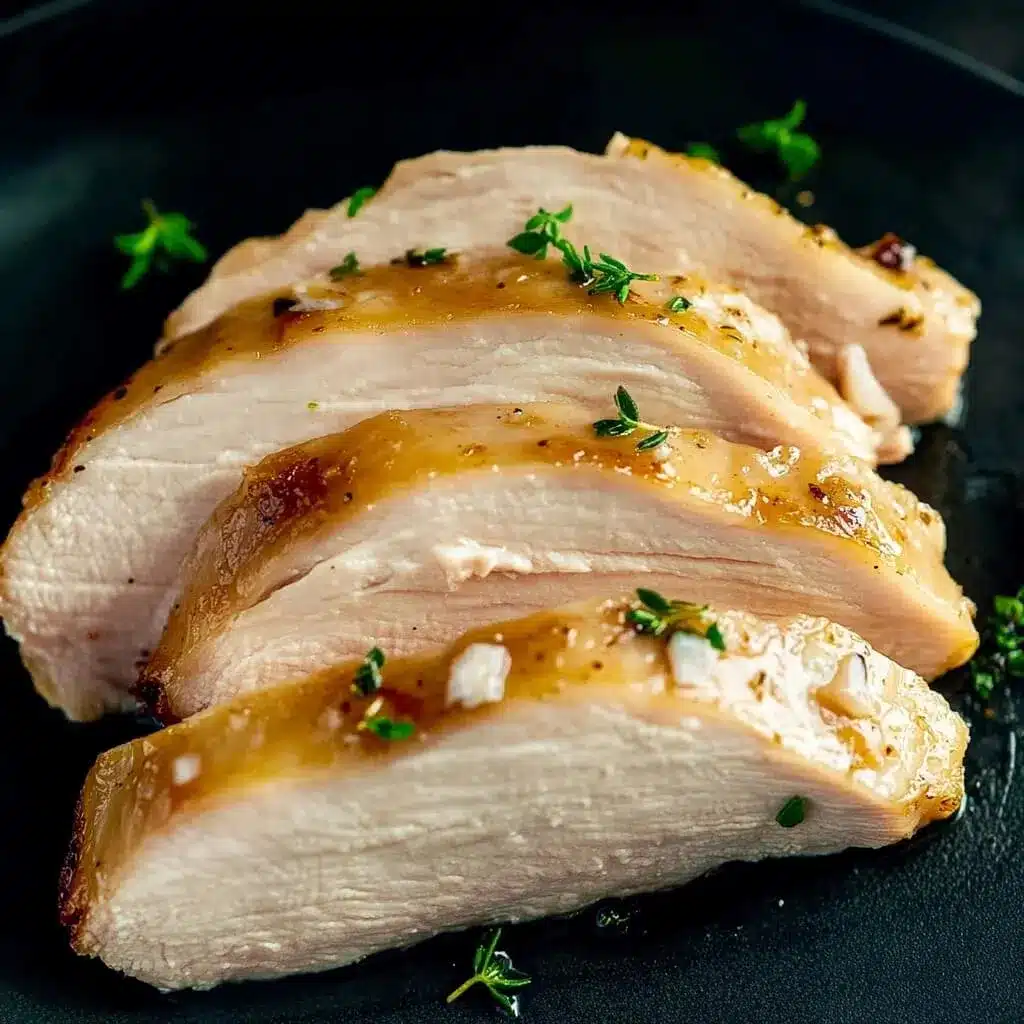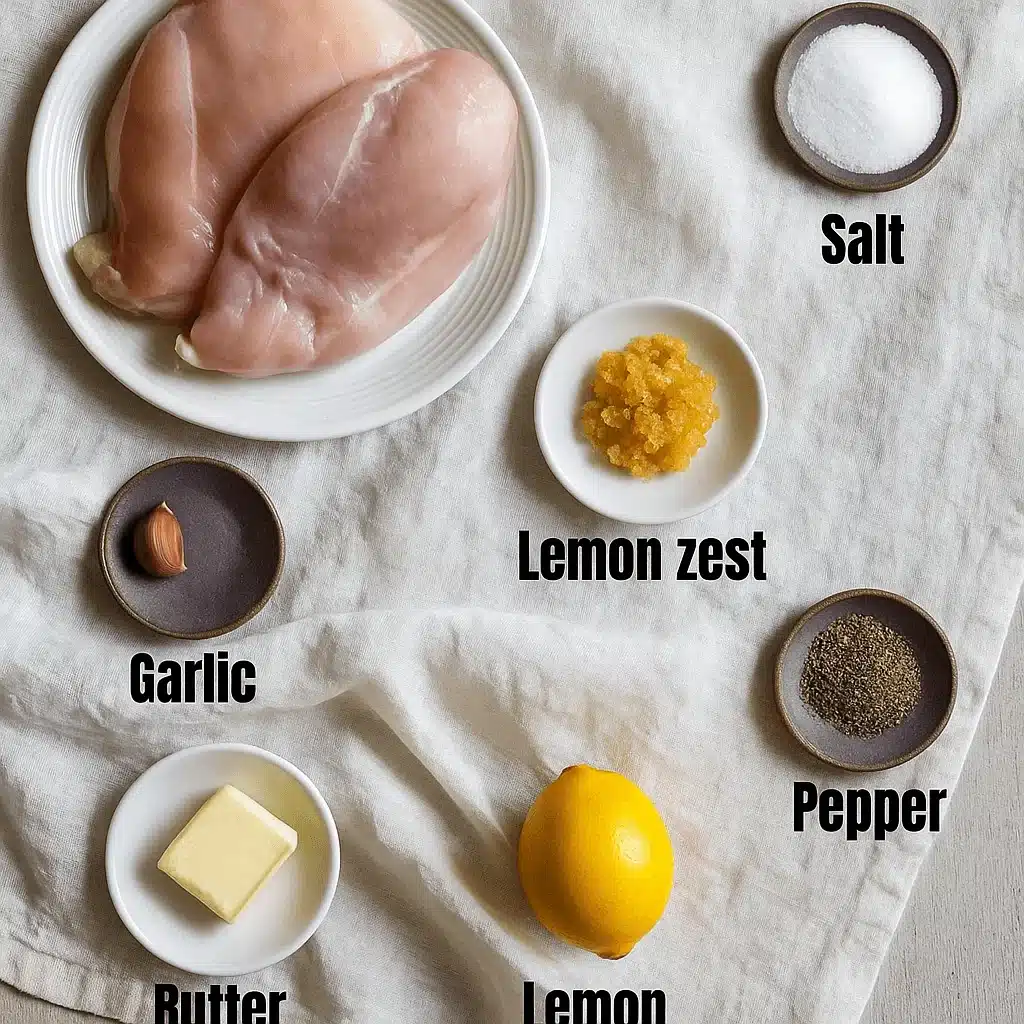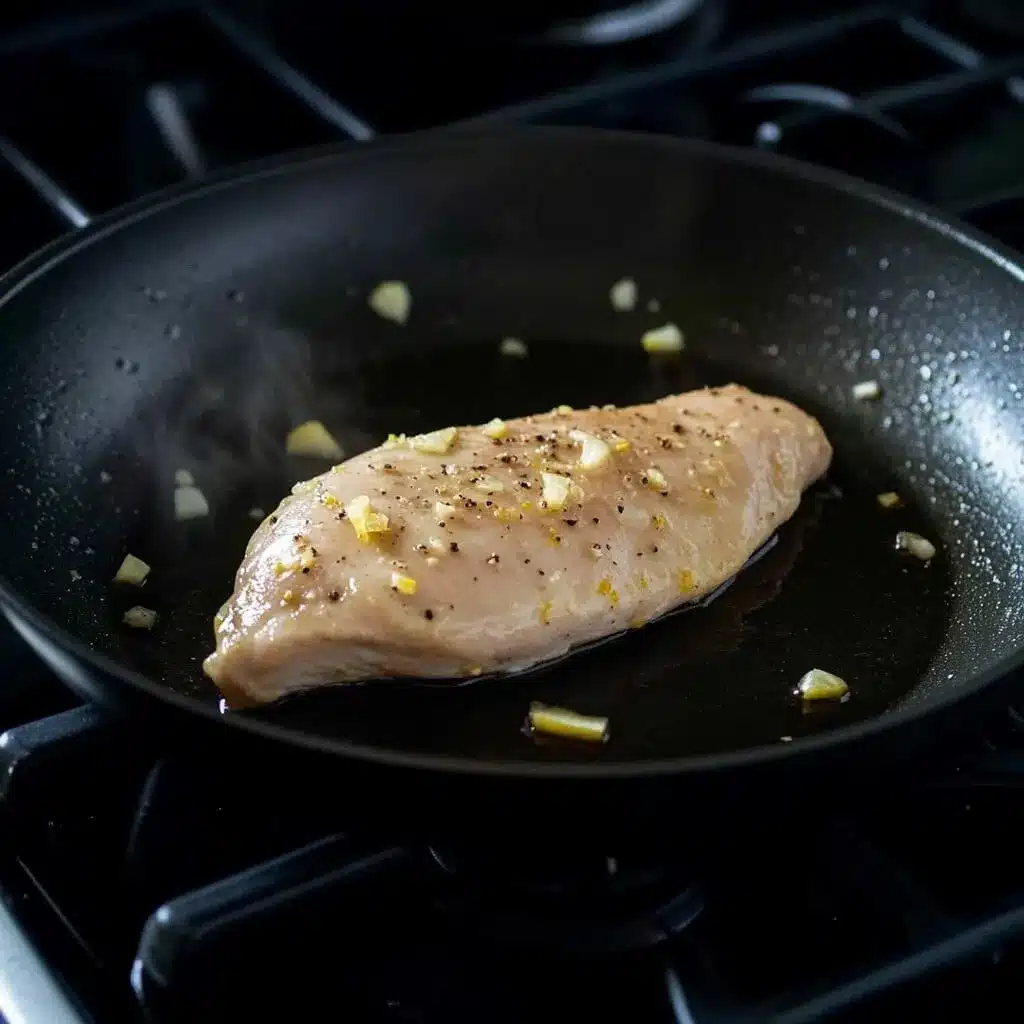Sous vide frozen chicken breast is the ultimate dinner solution when time’s tight and the chicken’s still frozen. No thawing, no stress—just perfectly juicy chicken every time.
I’ve spent over a decade helping busy people make high-protein meals that feel like comfort food. And let me tell you: nothing beats a simple, flavorful chicken breast that goes straight from freezer to fork without skipping a beat.

In my Austin kitchen (usually with my kids and golden retriever at my feet), I’m all about foolproof recipes you’ll actually cook. Sous vide changed everything for me—and it can for you too.
Let’s make chicken the easiest part of your day.
Table of Contents
Table of Contents
Why Sous Vide Frozen Chicken Breast Is a Game Changer
How Sous Vide Transforms Frozen Chicken
Sous vide frozen chicken breast isn’t just a kitchen hack—it’s a complete transformation in how we cook dinner. By sealing the chicken in an airtight bag and gently cooking it in a water bath, sous vide keeps every ounce of moisture locked in. The result? Perfectly tender, juicy chicken with zero thawing required.
Whether your chicken is rock-solid from the freezer or freshly packed, the sous vide technique works the same way. It heats the food gradually, bringing it to a precise internal temperature without overcooking. That’s why sous vide frozen chicken breast always turns out evenly cooked, flavorful, and melt-in-your-mouth delicious.
The best part? You don’t need to hover over a skillet or guess if your chicken’s fully cooked inside. Sous vide eliminates the guesswork and delivers consistently moist chicken—making it the perfect method for busy nights, meal prepping, or anyone who forgot to take the meat out of the freezer (guilty!).
Benefits Over Traditional Defrosting Methods
Let’s face it: defrosting chicken in the microwave is basically a gamble. Parts of it start to cook, others stay frozen, and you’re left with a half-dry mess that you’re somehow still supposed to season and serve. Not exactly comforting.
Traditional defrosting in the fridge takes hours (sometimes days), and quick defrosting in water can be unsafe if not done properly. That’s where sous vide frozen chicken breast steals the show.
Here’s what makes it better:
| Traditional Defrosting | Sous Vide Frozen Chicken |
|---|---|
| Uneven thawing | Even, controlled cooking |
| Time-consuming prep | Set it and forget it |
| Higher risk of overcooking | Precision temperature control |
| Often dries out meat | Locks in moisture |
Instead of compromising flavor and texture just to get dinner on the table, sous vide allows you to make tender, flavorful chicken directly from the freezer—no extra planning required.

Sous Vide Frozen Chicken Breast
Ingredients
- 2 chicken breasts boneless, skinless
- 2 tablespoons unsalted butter
- 2 teaspoons salt
- ¼ teaspoon black pepper
- ½ teaspoon lemon zest
- 1 tablespoon honey
- ½ teaspoon garlic powder
- Fresh lemon for serving
Instructions
- Heat a sous vide water bath to 140°F degrees.
- Combine the chicken breasts and remaining ingredients in a vacuum seal bag and seal.
- Cook for 2 ½ – 3 hours.
- Remove from the bag, reserving the bag juice.
- Heat a skillet over medium high heat and brown the chicken breast for 30 seconds on each side (be careful not to overcook).
- Serve drizzled with the bag sauce and fresh lemon juice.
Nutrition
Preparing Chicken Breasts Straight from the Freezer
Choosing Quality Chicken for Sous Vide
When it comes to cooking sous vide frozen chicken breast, the quality of the meat makes a big difference. Start with boneless, skinless chicken breasts that are fresh-frozen, plump, and ideally free of added water or preservatives.
Choose chicken labeled:
- Individually quick frozen (IQF) or air-chilled for best texture
- No added sodium solutions, which can affect flavor and juiciness
- Even in size, so each breast cooks at the same rate in your sous vide bath
Pre-portioning your chicken before freezing helps a lot. You can package them individually or in meal-sized sets, ready to cook whenever you need them.
How to Season and Vacuum-Seal Before Freezing

Here’s a time-saving trick: season your chicken before freezing it. That way, when it’s time to make sous vide frozen chicken breast, you just drop the prepped bag into the water bath—no need to thaw or season.
Follow these steps for freezer-ready success:
| Step | Action |
|---|---|
| 1 | Dry chicken with paper towels. |
| 2 | Season both sides with salt, pepper, lemon zest, and garlic powder. |
| 3 | Add a teaspoon of olive oil or a pat of butter to each bag. |
| 4 | Vacuum seal tightly or use the water displacement method with freezer bags. |
| 5 | Label with the date and seasonings used. Store flat for convenience. |
This method locks in flavor and saves time. When you cook frozen chicken breast sous vide, the gentle heat allows the seasoning to slowly infuse the meat. No loss of taste, no last-minute prep.
If using pre-packaged frozen chicken, you can still get amazing results. Cook the chicken first, then season or sear right before serving for a flavor boost.
Freezing chicken with seasoning ahead of time is a small step that makes a big difference. It turns a frozen protein into a ready-to-cook dinner that feels fresh, juicy, and flavorful.
Whether you’re prepping for a busy week or just want dinner on autopilot, having sous vide frozen chicken breast ready in the freezer is one of the smartest kitchen moves you can make.
Cooking Times and Temperatures for Frozen Sous Vide Chicken
Ideal Temperature for Tender, Safe Chicken
One of the biggest benefits of cooking sous vide frozen chicken breast is having total control over the final texture. Whether you like your chicken super soft or firm and sliceable, it all comes down to temperature—and sous vide lets you dial it in perfectly.
Here’s a helpful guide:
| Temperature | Texture | Time (from frozen) |
|---|---|---|
| 140°F (60°C) | Juicy and tender | 2.5–3 hours |
| 145°F (62.8°C) | Slightly firmer, still moist | 2.5–3 hours |
| 150°F (65.6°C) | Traditional firm texture | 2.5–3 hours |
| 165°F (73.9°C) | Classic cooked chicken feel | 2.5–3 hours |
If you’re just starting with sous vide frozen chicken breast, 145°F offers the perfect balance—safe, flavorful, and moist. What’s even better? You can leave it in the bath for up to 4 hours without any loss in quality. It’s hands-off, stress-free cooking at its best.
Cooking Duration Chart for Different Sizes
Chicken breasts come in all shapes and sizes—and with sous vide, a little planning goes a long way. Larger or thicker pieces may need extra time to ensure they’re fully heated through.
Here’s a quick breakdown for sous vide frozen chicken breast timing:
| Chicken Breast Size | Recommended Cook Time |
|---|---|
| Small (4–5 oz) | 2.5 hours |
| Medium (6–8 oz) | 2.75 hours |
| Large (9–11 oz) | 3–3.25 hours |
| Extra Large (12+ oz) | 3.5 hours |
The beauty of cooking sous vide frozen chicken breast is how forgiving the process is. Even if you leave the chicken a little longer, the precise water temperature prevents it from overcooking or drying out.
Step-by-Step Guide to Sous Vide Frozen Chicken Breast
Tools You Need: Precision and Simplicity
Cooking sous vide frozen chicken breast doesn’t require a fancy setup. In fact, it’s one of the most beginner-friendly ways to make flavorful, juicy meals—especially when you have the right tools on hand.
Here’s a checklist of essentials:
- Sous vide immersion circulator – This is the heart of your setup. Brands like Anova or Joule are popular for their precision and ease of use.
- Large pot or heat-safe container – This holds your water bath. Make sure it’s tall enough for full submersion.
- Vacuum sealer or freezer-safe zip-top bags – A vacuum seal is ideal, but the water displacement method works just fine for casual cooks.
- Tongs – For removing the hot bag from the bath safely.
- Kitchen thermometer (optional) – For confirming bath temperature, especially if your circulator doesn’t have a digital display.
- Heavy object or sous vide weight – To prevent bags from floating.
Cooking Instructions from Start to Finish
Follow this no-fail method to make sous vide frozen chicken breast straight from the freezer to your plate:
- Preheat the water bath
Set your sous vide machine to your desired temperature. For juicy results, 145°F is a great target. - Drop the frozen, sealed chicken into the bath
No need to thaw—just make sure it’s fully sealed. If the bag starts to float, use a weight or clip it to the pot. - Cook for 2.5 to 3.5 hours
Time depends on the size of the chicken breast. Refer to the chart in Part 3 for ideal cook times. - Remove and dry
Take the bag out, open it carefully, and pat the chicken dry with paper towels. This step is crucial if you plan to sear. - (Optional) Sear for 30 seconds per side
Heat a skillet on high with a little oil or butter. Sear quickly to get golden edges. Be careful not to overcook—it’s already fully cooked inside. - Serve and enjoy
Drizzle with pan juices or fresh lemon juice, or toss in a quick sauce. Serve with your favorite sides or slice for salads and sandwiches.
Pro Tip: Save those juices in the bag! They make a flavorful base for pan sauces or can be spooned right over the chicken for extra moisture.
Searing for Flavor and Texture After Sous Vide
When and Why to Sear
After cooking sous vide frozen chicken breast, the meat is technically ready to eat—fully cooked, juicy, and tender. But if you’re craving that golden-brown crust or crave-worthy edge? Searing is your secret weapon.
Searing adds:
- Texture – That crisp outer layer gives each bite a satisfying contrast
- Flavor – Browning triggers the Maillard reaction, unlocking savory depth
- Visual appeal – A golden sear looks (and feels) more like traditional grilled chicken
Even though sous vide locks in juiciness, searing elevates the meal from “great” to “restaurant-quality.” This finishing touch applies not only to chicken breasts but also to other cuts like sous vide chicken wings, which benefit from a quick broil or pan sear to boost texture and flavor.
That said, searing is completely optional. If you’re using the chicken in a salad, wrap, or shredded in soup, you can skip the skillet.
Searing Techniques Without Overcooking
The most important rule when searing sous vide frozen chicken breast is to act fast. Since the chicken is already fully cooked, you only want to brown the outside—not reheat the interior.
Here’s how to do it right:
Quick Searing Guide

| Step | What to Do |
|---|---|
| 1 | Remove chicken from bag and pat very dry with paper towels. Moisture will cause steaming instead of searing. |
| 2 | Preheat a cast iron or heavy skillet over medium-high to high heat. Add a thin layer of high-smoke-point oil like avocado or grapeseed. |
| 3 | Add chicken and sear for 30 seconds per side. Press gently for full surface contact. Don’t move it too much. |
| 4 | Optional: Finish with butter, garlic, and herbs for an aromatic crust. |
| 5 | Remove from heat and let rest 1–2 minutes before slicing or serving. |
If you prefer the grill, you can also give the chicken a quick char over hot grates—but again, limit it to under 1 minute per side to avoid drying it out.
Common Mistakes and How to Avoid Them
Overcooking vs. Mushy Texture in Sous Vide
Sous vide cooking offers unmatched precision, but even when working with sous vide frozen chicken breast, time still matters. While this method reduces the risk of drying out meat, leaving it in the bath too long can lead to a texture that’s less than ideal.
At lower temps like 140°F, the protein structures begin to break down after 4 hours. The result? A soft, almost mushy consistency that lacks that satisfying bite.
Here’s how to avoid that:
- Keep your cook time between 2.5 and 3.5 hours
- Never exceed 4 hours—even with large cuts
- Use consistent portion sizes for even cooking
If you’re batch-cooking multiple servings of sous vide frozen chicken breast, using a timer helps ensure consistency across every bag.
Tips to Prevent Floating Bags and Water Leaks
One common challenge when preparing sous vide frozen chicken breast is keeping your bags properly submerged. Floating happens when air is left inside, and that leads to uneven cooking. Leaks are another issue—they can dilute flavor and waste effort.
Here’s how to solve it:
| Issue | Fix |
|---|---|
| Bag floats | Re-seal or add sous vide weights |
| Seal breaks | Use double bags or a trusted vacuum sealer |
| Water leaks in | Keep the seal line above water |
| Water evaporates | Cover your pot with foil or a lid |
Using sous vide racks or clips helps maintain stability and keeps your food in the perfect position. And if you’re using the water displacement method, double-check the seal before submerging.
Also, don’t skip the drying step before searing. Moisture on the surface will steam the chicken instead of giving you that golden finish.
When done right, sous vide frozen chicken breast offers incredible flavor, consistent results, and zero stress—even if you’re short on time or cooking experience.r experience with sous vide frozen chicken breast will stay foolproof, mess-free, and full of flavor.
Versatile Recipes Using Sous Vide Chicken Breast
Chicken Salad, Sandwiches, and Meal Preps
One of the best parts about making sous vide frozen chicken breast is how incredibly adaptable it is. Once it’s cooked, you can use it in dozens of different ways—whether you’re building out your weekly meal prep or tossing together a last-minute lunch.
Here are some go-to ideas:
- Chicken Salad Wraps – Dice the chicken and mix it with Greek yogurt, celery, mustard, and herbs for a high-protein, low-fat lunch.
- Sandwich Melts – Slice thin and layer onto whole-grain bread with melted cheese and sautéed onions.
- Power Bowls – Build bowls with brown rice or quinoa, veggies, avocado, and sliced chicken breast. Drizzle with a lemon tahini dressing.
- Tacos & Lettuce Wraps – Shred your chicken and toss it with taco seasoning or buffalo sauce for quick wraps or tacos.
- Yangnyeom Chicken – Toss your sous vide chicken in a spicy Korean-style sweet chili sauce, then top with sesame seeds for a bold, global twist.
Since the meat is already juicy and flavorful, it absorbs sauces and seasonings quickly. That makes sous vide frozen chicken breast ideal for batch cooking or quick weeknight dinners.
Quick Sauces and Side Dishes That Pair Perfectly
You don’t need complicated sides to complement your chicken. A few pantry staples go a long way when you want fast, healthy, and flavorful meals.
Here are some simple sauce pairings:
| Sauce | Flavor Profile |
|---|---|
| Lemon Herb Butter | Bright, savory, perfect with seared chicken |
| Honey Garlic | Sweet and tangy, ideal for rice bowls or wraps |
| Chimichurri | Fresh, herby, and adds a bold punch |
| Buffalo Yogurt | Creamy with heat, great for wraps or lettuce cups |
And don’t forget the sides! Pair your chicken with:
- Steamed broccoli or roasted green beans
- Air fryer sweet potato fries
- Garlic mashed cauliflower
- Basmati rice with herbs
Because sous vide frozen chicken breast is so moist, it works well in drier pairings like grains and roasted vegetables.
Nutrition Facts and Dietary Benefits
Caloric Breakdown and Macronutrients
One reason sous vide frozen chicken breast is so popular with health-conscious eaters is its impressive nutritional profile. You get high-quality lean protein without the added oils, breading, or heavy sauces that often come with traditional cooking methods.
Here’s a general breakdown for a 6-ounce cooked chicken breast (prepared sous vide with light seasoning):
| Nutrient | Amount |
|---|---|
| Calories | 280–310 kcal |
| Protein | 50–55g |
| Fat | 7–10g (depending on added oil or butter) |
| Carbohydrates | 0–2g |
| Sodium | Varies by seasoning, typically 400–600mg |
Because sous vide doesn’t require additional cooking fat, and keeps moisture sealed inside, you can achieve a rich, juicy result without sacrificing nutrition. It’s perfect for clean eating, macro-tracking, and portion control.
Even indulgent recipes like Honey Butter Fried Chicken can start with sous vide—ensuring tenderness before finishing in a quick honey-butter glaze for maximum flavor.
Is Sous Vide Chicken Ideal for Weight Loss?
Absolutely. Sous vide frozen chicken breast is a lean protein source with a high satiety index—meaning it helps you feel fuller longer. That makes it excellent for calorie-conscious diets, intermittent fasting, and low-carb or keto meal plans.
Benefits include:
- Portion control – Easy to measure exact servings
- No added fats – You control every ingredient
- Great for meal prep – Pre-cook multiple portions for the week
- Pairs with veggies, grains, or salads – Making it flexible for different goals
In fact, many athletes, fitness coaches, and registered dietitians recommend sous vide chicken as part of a balanced weekly plan due to its consistent texture and nutritional accuracy.
Whether you’re trying to lean out or just eat cleaner, sous vide frozen chicken breast helps simplify healthy eating without sacrificing flavor.
Final Thoughts on Sous Vide Frozen Chicken Breast
If you’ve been relying on last-minute takeout or dry, rushed meals, it’s time to try something that’s both smarter and simpler. Cooking sous vide frozen chicken breast is hands-down one of the easiest ways to turn a freezer-stashed protein into a restaurant-worthy dinner—without thawing, guessing, or hovering over the stove.
From consistent doneness to endless versatility, this method gives you total control. Whether you’re prepping meals for the week, throwing together a quick dinner, or feeding your family something wholesome and satisfying, sous vide chicken checks every box.
Ready to make your next meal juicy, tender, and totally stress-free? Let the sous vide do the work—and enjoy flavorful results every time.
Follow Easy Protein Kitchen on Pinterest for daily recipes and foodie favorites!
FAQs About Sous Vide Frozen Chicken Breast
Can you cook frozen chicken breast in a sous vide?
Yes, you absolutely can. In fact, sous vide frozen chicken breast is one of the easiest and most reliable ways to cook chicken straight from the freezer. There’s no need to thaw first. Just vacuum seal or use a freezer-safe zip bag, drop it into the preheated water bath, and cook for 2.5 to 3.5 hours depending on size. The meat comes out juicy, tender, and evenly cooked every time.
Should you marinate chicken breast before sous vide?
You can, but it’s not required. If you’re working with sous vide frozen chicken breast, you can season and vacuum seal the meat before freezing. The flavors will gently infuse during the long, slow cook. Avoid strong acidic marinades (like lemon or vinegar-heavy blends) as they can make the texture mushy over time. Dry rubs or herb-infused butter work beautifully for freezer-to-sous vide prep.
Why is my sous vide chicken rubbery?
If your chicken turns out rubbery, a few factors could be at play:
Too high a temperature – Chicken cooked at 165°F or above can tighten the muscle fibers too much
Not enough cook time – Undercooked chicken from frozen won’t tenderize properly
Incorrect thickness or uneven portions – Always use uniform cuts for consistent texture
For the best results with sous vide frozen chicken breast, stick to 140–145°F and allow at least 2.5 hours of cooking.
Is it safe to sous vide chicken at 145 degrees?
Yes, it is safe to cook sous vide frozen chicken breast at 145°F. This temperature is high enough to kill harmful bacteria as long as you maintain it for the correct duration—about 2.5 to 3.5 hours. Unlike traditional cooking, sous vide brings food to temperature gradually and holds it there, ensuring food safety and juiciness.
